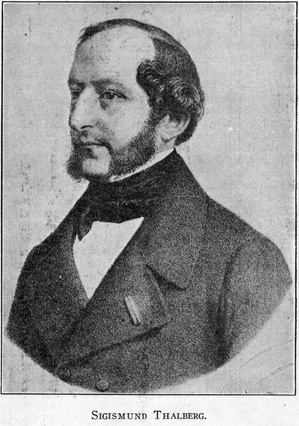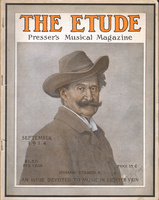By AUBERTINE WOODWARD MOORE
Including the Author’s Personal Recollections of Thalberg’s American Tours.
Nothing could better illustrate the transitoriness of a virtuoso’s fame than the neglected centenary, January, 1912, of the once popular Thalberg. Although by no means the most eminent of other-day musicians whom the present day condescendingly pronounces quite out of date, he is nevertheless a personality to whom the musical world owes a debt that should neither be overlooked nor lightly estimated.
 It was he who unfolded to the laity the beauty and infinite variety of tone that might be derived from the pianoforte through the proper use of its resources. He emphasized the art of singing on the instrument and instituted in a free employment of the thumb and ingenious combinations and changes of the fingers now so universally adopted that no one thinks of tracing them to their source. Numerous figures of entirely novel form were invented by him and were widely imitated and elaborated. His technical specialty, a feature which contributed so largely to the fame of his fantasias, was his mode of sustaining a central melody, with the aid of the thumbs and damper pedal, and surrounding it with a halo of iridescent runs and arpeggios supplemented by full rich chords.
It was he who unfolded to the laity the beauty and infinite variety of tone that might be derived from the pianoforte through the proper use of its resources. He emphasized the art of singing on the instrument and instituted in a free employment of the thumb and ingenious combinations and changes of the fingers now so universally adopted that no one thinks of tracing them to their source. Numerous figures of entirely novel form were invented by him and were widely imitated and elaborated. His technical specialty, a feature which contributed so largely to the fame of his fantasias, was his mode of sustaining a central melody, with the aid of the thumbs and damper pedal, and surrounding it with a halo of iridescent runs and arpeggios supplemented by full rich chords.
Sigismund Thalberg was born in Geneva, January 7, 1812. His father, Prince Dietrichstein, while failing to endow the boy with an ancestral name and title, reared him in the lap of luxury, and from 1822, in Vienna, surrounded him with every opportunity for broad culture the age and place afforded. A career in the diplomatic service had been planned for young Sigismund, but at fourteen he made his choice for music, with the piano as his medium of expression, thenceforth devoting his best energies to the art. In 1830, after several years of successful local appearances, he began his dazzling series of European and foreign tours, everywhere the conqueror by virtue of his combined artistry and personal charm. When he was launched on his career as a virtuoso, his father equipped him with a capital of $100,000, and he never had occasion to undergo the struggles with poverty which have oppressed so many artists.
A KEYBOARD DUEL WITH LISZT.
The most thrilling experience of his existence, his keyboard duel with Franz Liszt, began in Paris in 1835. The musical world of the French metropolis was for some time as completely split by the controversy in regard to the respective merits of the two virtuosi, as it had been in the previous century by the Gluckists and the Piccinnists. Thalberg and Liszt, both being gentlemen, were little inclined to share the animosity of their partisans. Once, at the outset, Liszt, stooping below his usual standards, printed a scathing attack on his rival, but promptly apologized for it, admitting that jealousy at seeing another than himself the idol of the Parisians had prompted the attack. Thalberg unhesitatingly pronounced Liszt one of the greatest pianists in Europe, and Liszt said of him that he was the only artist who could play the violin on the piano. Many benefits arose from the Paris ivory-warfare. It stimulated Liszt to put forth his best energies and accomplish more than he might otherwise have done, and it riveted the attention of the entire cultured world on the beauty of pure tone and the infinite variety of this that belonged to the realm of the piano. That Liszt triumphed in the end was due to his more intense personality and his larger creative powers. The cartoonists were as busy with these two men in their day as they became later with Paderewski. Liszt was caricatured with wildly floating hair and exaggerated attitudes and environments, while Thalberg was represented as seated with rigid dignity before a box of keys.
THALBERG IN AMERICA.
During the season of 1856-7 Thalberg came to the United States, and it was in Philadelphia that I, an ambitious but as yet poorly informed young piano student, received from him my first glimpse of the tonal possibilities of the pianoforte. He was touring the country with the famous violinist Vieuxtemps, and I can vividly recall the impression both artists made upon me. They were the most distinguished artists I had then ever seen or heard, and I watched them and listened to them with a feeling akin to awe. Both seemed to me like far-away story-book men, both appeared statuesque and cold, and yet both kindled within me emotions music had never before aroused.
I can close my eyes and see him now as he moved forward on the platform, a refined, distinguished-looking gentleman, every inch the aristocrat. Approaching the piano with unruffled tranquillity, without the least sign of fuss and feathers, he greeted the audience with the unaffected dignity and air of inbred propriety that enveloped him, and taking his seat quietly before the keyboard began to play.
HOW THALBERG PLAYED.
I had been accustomed to public performers who violently belabored their inoffensive, long-suffering pianos, who indulged in wild, fantastic gyrations in the air, with hands and arms, and who elevated their shoulders, distorted their entire bodies with exaggerated antics and their countenances with ridiculous gestures.
How different it was with Thalberg! He was perfectly composed, convincing the observer from the outset that he was master of the keyboard and of himself. Not a gesticulation, not a change of countenance, not a stolen glance toward the audience betrayed the slightest agitation, or indicated that his thoughts were occupied with aught else than his work. Applause was received by him with a respectful inclination of the head, and not the slightest deviation from his courtly bearing. That he was not as frigid as his demeanor betokened was betrayed by the soft flush that at times gradually suffused face, ears and neck.
MAKING THE PIANO SING.
In the most minute details his style was polished, finished and so clean and accurate it would have astonished one to hear a wrong note. His runs and arpeggios were crystal clear, now delicate as fairy network, now rolling like magnificent billows; his trill was perfect; his octaves and chords faultless, and his cantabile something that could never be forgotten. He made a melody sing on the piano, as I had then never thought it could be sung by other than the human voice. I remember watching fascinated the play of his feet on the pedals, not realizing at the time how much he helped himself through them to his effects.
Touch, tone and technique may have been his adored trinity, but he certainly used them in a manner to cause beneficent results. He never pounded; what he sought and produced was pure tone, full, round, velvety and gently graded from exquisite softness to large volume. His was the most beautiful tone I had then heard, although later I knew something bigger, nobler, more impassioned in the tone of Rubinstein, who, of course, played on an instrument twenty years further advanced than that Thalberg used.
“THE ART OF SINGING ON THE PIANOFORTE.”
A noteworthy contribution to the science of touch and tone is The Art of Singing on the Pianoforte by Thalberg, printed as an introduction to a series of paraphrases meant to illustrate its teachings. These may be given in brief, as follows:
“Sentiment brings into play the inventive faculty, and the need of expressing what one feels will develop resources that might have eluded the mere technician.
“The Art of Song is ever the same, no matter to what instrument it may be applied. Neither concessions, nor sacrifices should be made to the mechanism of the particular instrument used, it is rather the business of the interpreter to adapt this to the demands of art.
“One of the first essentials in obtaining beautiful sonority and variety of tone is a complete freedom from rigidity. It is therefore an indispensable requisite to have the forearm, wrist and fingers as supple and well under control as a skillful singer must have the vocal apparatus.
“Broad, lofty, dramatic songs must be sung with full voice; much, therefore, is to be demanded from the instrument from which the greatest volume of tone must be drawn, though never by roughly striking the keys, rather by pressing them with firmness, decision and warmth. For simple, tender and graceful melodies the keys should be felt rather than struck.
MAKING THE MELODY STAND OUT.
“The melody should stand out clear and distinct above the accompaniment, as a human voice above the orchestra. Notes may be sustained by substituting one finger for another, or by skilful use of the damper pedal, each in the proper place. The pedals should be employed with infinite discretion, and careful attention must be paid to marks of expression.
“In general, pianists play too fast, and think they have accomplished a great deal when they have gained finger agility. Playing too fast is a capital offence. The execution of a simple three or four-voiced fugue, in a correct manner, requires and proves more talent than the performance of the most brilliant and rapid piano composition. It is far more difficult than one can well imagine to avoid hurrying.
“The young player is urgently commended to exercise great sobriety in the movements of the body, and great tranquillity in hand and arm motion; never to begin the piano attack at too great a distance from the keys; to listen carefully to one’s own playing; to be strict with one’s self and learn to criticize one’s self. The average player works too much with the fingers and too little with the mind.
“To those occupying themselves seriously with the pianoforte, we can give no better advice than to learn, study and thoroughly test the beautiful art of singing. We will add that we ourselves studied singing during five years under the direction of one of the most celebrated teachers of the Italian School.”
About a year after his American tour, Thalberg, who from the early thirties had made his home in Paris, settled on an estate he purchased in Posilippo, near Naples, where, as a landowner, he cultivated extensive vineyards. Several times he was induced to go abroad for concerts, and professionally to revisit Paris, Landon and Brazil. In 1864, just fifty years ago, when only in his fifty-third year, he made his last public appearance and retired permanently to Posilippo, where he lived the remainder of his life as a cultivator of the soil. He died April 27, 1871.
A STRANGE WHIM.
The strangest feature of his retirement was the fact that he would not permit a piano within his home. There seems to be no explanation for his turning from what he had loved so well and by means of which he had accomplished so much, unless he had awakened to the futility of tone for tone’s sake alone, and was overwhelmed by the thought of glorious interpretations and tonal creations he was not fashioned to accomplish. I cannot believe with some that he was merely actuated by jealousy of Liszt rankling in his soul to the end.



